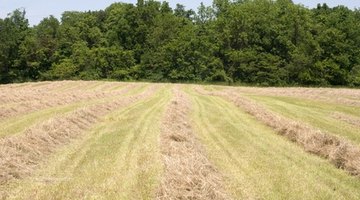How to Build a 4-Wheel Hay Wagon
If you have a farm to run, you move tons of hay from the field to the barn. And, if all you have is a pick-up truck, the task of baling and loading the hay is exhausting. Using a hay wagon reduces the stress on you and your regular farm equipment, but hay wagons aren't cheap. As much as they simplify the process of transporting hay, they may not fit into your budget. Instead, build your own four-wheeled hay wagon from a junkyard car chassis and a few other parts for much less.

-
Construct the wagon tongue. Drill a 3/4-inch hole through two steel bars stacked on top of each other. Weld the pieces together onto one end of the chassis frame. Align the holes, with one bar on the top of the side frame and one on the bottom, with a few inches distance between them. Insert a hinge bolt through the set of holes.
-
Mount the tongue bracket so it can pivot horizontally between the two steel bars. Mount and link the bracket to the front wheels of the chassis with short lengths of angle iron. Weld the iron to the metal rods and attach the rods to the tongue bracket with jam nuts.
-
Weld two small steel plates to the other end of the tongue bracket and drill holes through them. This allows you to hook the wagon to a vehicle, such as a truck or tractor.
-
Stabilize the wagon's suspension. This prevents problems later on if a heavy load of hay sinks the wagon bed to the level of the tires. Weld a solid piece of angle iron between the axle and frame of the chassis so there is no give between the chassis's wheels and its bed.
-
Construct the base of the wagon. Install two 16-foot pieces of lumber lengthwise down both sides of the frame, spaced 4 feet apart. Weld two pieces of flat steel onto the humps over the chassis' rear axle, and weld two pieces of angle iron vertically onto the back end of the frame. Lay a piece of lumber across the frame and bolt it to the angle iron. Make sure this piece is tall enough that the lengthwise support beams rest on the plank and the humps at the rear axle.
-
Lay down a second crossbeam at the front of the wagon bed. Lay down the sheeting boards to cover the bed of the wagon. Nail in place.
-
Install long boards around the sides of the wagon rack to hold the sheeting planks together and distribute the weight more evenly over the floorboards. Nail in place.
References
Tips
- If desired, build high sides for the hay wagon to stack the bales vertically, and to keep them in place as you haul the hay.
Warnings
- Mount the tongue securely and make sure the welding is strong. The entire weight of the fully-loaded hay wagon is pulled from the tongue, spelling a serious safety hazard if the joint fails.
Writer Bio
Michelle Labbe has been writing online and for print since 2004. Her work has appeared in the online journals Reflection's Edge and Cabinet des Fées as well as in Harvard Book Store's anthology, "Michrochondria." She is pursuing a Master of Arts in publishing and writing at Emerson College.
Photo Credits
- Making hay image by Allen Stoner from Fotolia.com
More Articles



